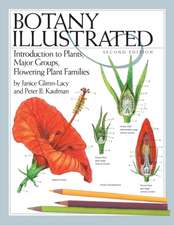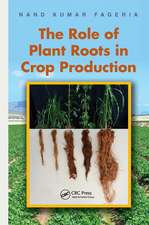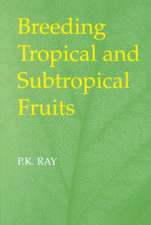Standardized Hierarchical Vegetation Classification: Mexican and Global Patterns: Geobotany Studies
Autor Alejandro Velázquez, Consuelo Medina García, Elvira Durán Medina, Alfredo Amador, Luis Fernando Gopar Merinoen Limba Engleză Hardback – 24 aug 2016
| Toate formatele și edițiile | Preț | Express |
|---|---|---|
| Paperback (1) | 884.07 lei 6-8 săpt. | |
| Springer International Publishing – 15 iun 2018 | 884.07 lei 6-8 săpt. | |
| Hardback (1) | 640.24 lei 6-8 săpt. | |
| Springer International Publishing – 24 aug 2016 | 640.24 lei 6-8 săpt. |
Din seria Geobotany Studies
- 15%
 Preț: 643.00 lei
Preț: 643.00 lei - 20%
 Preț: 566.77 lei
Preț: 566.77 lei - 15%
 Preț: 636.80 lei
Preț: 636.80 lei - 15%
 Preț: 704.04 lei
Preț: 704.04 lei - 19%
 Preț: 550.79 lei
Preț: 550.79 lei - 15%
 Preț: 638.24 lei
Preț: 638.24 lei - 15%
 Preț: 651.51 lei
Preț: 651.51 lei - 15%
 Preț: 649.06 lei
Preț: 649.06 lei - 20%
 Preț: 589.58 lei
Preț: 589.58 lei - 18%
 Preț: 961.10 lei
Preț: 961.10 lei - 15%
 Preț: 644.95 lei
Preț: 644.95 lei - 15%
 Preț: 662.80 lei
Preț: 662.80 lei - 18%
 Preț: 945.30 lei
Preț: 945.30 lei - 18%
 Preț: 948.61 lei
Preț: 948.61 lei - 18%
 Preț: 1009.22 lei
Preț: 1009.22 lei - 18%
 Preț: 890.37 lei
Preț: 890.37 lei - 24%
 Preț: 784.08 lei
Preț: 784.08 lei - 19%
 Preț: 459.25 lei
Preț: 459.25 lei - 18%
 Preț: 1115.77 lei
Preț: 1115.77 lei - 18%
 Preț: 1115.46 lei
Preț: 1115.46 lei
Preț: 640.24 lei
Preț vechi: 753.22 lei
-15% Nou
Puncte Express: 960
Preț estimativ în valută:
122.52€ • 133.04$ • 102.92£
122.52€ • 133.04$ • 102.92£
Carte tipărită la comandă
Livrare economică 22 aprilie-06 mai
Preluare comenzi: 021 569.72.76
Specificații
ISBN-13: 9783319412214
ISBN-10: 3319412213
Pagini: 149
Ilustrații: XXIII, 143 p. 6 illus., 4 illus. in color.
Dimensiuni: 155 x 235 x 11 mm
Greutate: 0.41 kg
Ediția:1st ed. 2016
Editura: Springer International Publishing
Colecția Springer
Seria Geobotany Studies
Locul publicării:Cham, Switzerland
ISBN-10: 3319412213
Pagini: 149
Ilustrații: XXIII, 143 p. 6 illus., 4 illus. in color.
Dimensiuni: 155 x 235 x 11 mm
Greutate: 0.41 kg
Ediția:1st ed. 2016
Editura: Springer International Publishing
Colecția Springer
Seria Geobotany Studies
Locul publicării:Cham, Switzerland
Cuprins
Foreword.- Historical Survey.- Background on Vegetation Classification Systems.- Proposal for a Standardized Hierarchical System for the Classification of Vegetation In Mexico.- The Inclusive Nature of Seclavemex.- Seclavemex Aimed at Integrating Landcover and Vegetation Mapping.- Epilogue.- Appendices.
Textul de pe ultima copertă
This book outlines the transitions between cultured and natural land cover/vegetation types and their implications in the search for alternatives to reverse the trend of anthropogenic environmental degradation. It also elaborates on the proposed “standardized hierarchical Mexican vegetation classification system” and geobotanical mapping, a critical transversal environmental issue. The first chapter consists of an historical review of the common approaches to the study of vegetation both in Mexico and in other regions of the world. The second chapter concisely analyzes the existing schools of thought that have led to the development of vegetation classification systems based on physiognomic, structural and floristic approaches. The focal point of the book is the “standardized hierarchical Mexican vegetation classification system” (SECLAVEMEX – “Sistema jerárquico estandarizado para la clasificación de la vegetación de México”). Chapter 3 describes the system’s organizational levels along with the criteria defining them and the nomenclatural basis for the denomination of each type of vegetation. It also includes a series of tables explaining and precisely defining the meaning of each concept, criterion, character and element used to help readers successfully identify the type of vegetation in a determined area. The fourth chapter highlights SECLAVEMEX's inclusive character as evidenced through its compatibility with other systems currently used around the globe. Three concepts are critically reviewed: land cover, land use and vegetation. These are often the study subject of the contrasting disciplines geography, agronomy and ecology, which all rely upon plant species assemblages. As such, the final chapter focuses on a critical transversal environmental issue – geobotanical mapping. Geobotanical mapping offers a baseline for land cover/use planning and provides critical information on ecological, economic and cultural attributes, which can be used as a basis for environmental-policy decisions. The proposed SECLAVEMEX was applied to Mexico as an example of land cover, land use and vegetation patterns intermingling as the result of a long human influence. SECLAVEMEX, however, can be adapted and hopefully adopted globally as a baseline for consistently comparing geobotanical patterns and their transitions.
Caracteristici
Presents a framework for combining land cover, land use, and vegetation for mapping purposes Offers an innovative geobotanical classification system, suitable for use around the globe Provides access to high-quality geobotanical maps Includes supplementary material: sn.pub/extras












